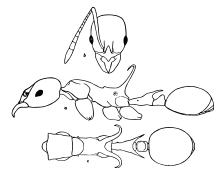Ancyridris
| Ancyridris | |
|---|---|
 | |
| A. polyrhachioides worker | |
| Scientific classification | |
| Kingdom: | Animalia |
| Phylum: | Arthropoda |
| Class: | Insecta |
| Order: | Hymenoptera |
| Family: | Formicidae |
| Subfamily: | Myrmicinae |
| Tribe: | Crematogastrini |
| Genus: | Ancyridris Wheeler, 1935 |
| Type species | |
| Ancyridris polyrhachioides Wheeler, 1935 | |
| Species | |
| |
| Diversity[1] | |
| 2 species | |
Ancyridris is a small genus of myrmicine ants, with only two described species from New Guinea.
Description

a) Lateral view
b) Head, dorsal view
c) Thorax and abdomen, dorsal view
The eyes are well developed. The long and narrow mesosoma is shaped somewhat as in Aphaenogaster. The propodeum bears two long, flattened, hooked spines resembling those of Polyrhachis bihamata. On the pronotum there are long hairs. The worker of A. polyrhachioides is almost 6 mm long. Apart from the curious anchor-like spines on its propodeum, Ancyridris bears a general resemblance to Aphaenogaster or certain worker forms of Pheidole. Wheeler suspected some aberrant or archaic group, "another of the living fossils which are continually turning up in the Papuan and Australian Regions".[2] Ancyridris in fact seems close to Lordomyrma. It is the only ant genus currently thought to be endemic to the island of New Guinea.
A. rupicapra was originally described in the genus Pheidole (Pheidolacanthinus). Its workers are 4 mm long.[3] A. polyrhachioides is black, and A. rupicapra reddish-brown (as implied by its specific epithet which translates as "red goat", referring as well to the goat-horn like propodeal spines. The sole known rupicapra specimen was collected in the mountains of the Sepik River catchment by the German colonial Kaiserin Augustafluss Expedition (1912–13).
The two original type specimens of A. polyrhachioides were recovered somewhat damaged from the stomach of an eastern blue-grey robin (Peneothello cyanus subcyaneus)[4] which was caught on Mount Misim in the Morobe District of New Guinea.[2]
Name
The genus name is derived from Ancient Greek αγκυρος "anchor" and ιδρις "the knowing/provident one", Hesiod's name for an ant,[5] probably Messor barbarus or M. structor.[2]
References
- ↑ Bolton, B. (2014). "Ancyridris". AntCat. Retrieved 18 August 2014.
- 1 2 3 Wheeler, William M. (1935): Two new genera of myrmicine ants from Papua and the Philippines. Proceedings of the New England Zoological Club 15: 1-9. PDF fulltext
- ↑ Stitz, H. (1938): Neue Ameisen aus dem indo-malayischen Gebiet ["New ants from the Indo-Malayan region"] [Article in German]. Sitzungsberichte der Gesellschaft Naturforschender Freunde zu Berlin 1938: 99-122. PDF fulltext
- ↑ "Poecilodryas cyanea subcyanea" in Wheeler (1935) is a lapsus - though placed in Poecilodryas at that time, the specific epithet was cyana.
- ↑ in: Works and Days, verse 778, in the text adopted in the Loeb Classical Library
External links
 Media related to Ancyridris at Wikimedia Commons
Media related to Ancyridris at Wikimedia Commons- AntWeb: Pictures of Ancyridris species